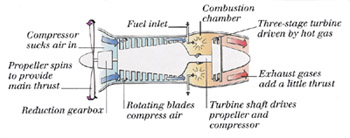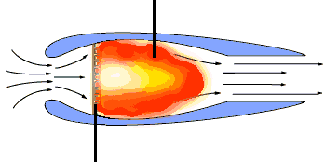Jet Engines (Part 2)
Turboprop

http://www.aeromuseum.org/Education/Lessons/HowPlaneFly/HowPlaneFly.html
The turboprop (turbo propeller) engine combines the simple propeller engine with that of the turbojet. In this case, in addition to driving the compressor, the turbine also drives a propeller. The propeller provides thrust like a normal propeller (the wedge shape of the blades pushes the air back), in addition to the thrust produced by the turbojet part of the engine.
Ramjet
http://www.aeromuseum.org/Education/Lessons/HowPlaneFly/HowPlaneFly.html
The ramjet engine is a much simpler construction than either the propeller or turbojet engine. Unlike these the other engines that require moving parts (propeller, compressor, turbine, shaft, etc), the ramjet consists basically of a tube that scoops the air into the combustion chamber where it is mixed with fuel and ignited, and exhausts the hot gasses through the necked down exhaust nozzle. Because of the high speeds of operation, instead of compressing the air, the chamber of the ramjet actually expands and thereby slows the air to subsonic speeds for the combustion process. The force of the incoming air forces the combustion to be kept behind the inlet. Because of this fact, the engine cannot be operated at subsonic velocities (Velocities below Mach 1 - One time the speed of sound or roughly 740 mph at standard temperature and pressure). Hence another engine has to accelerate the plane to the point where the ramjet can function.
On the other hand, because of its simplistic construction, the ramjet engine can withstand speeds at which the turbojet components would be torn apart, so once the engine is running, it can operate at speeds up to Mach 5.

